

|
Being the account of a walk through the Velay and the Cevennes in France in July 2008 on the Stevenson Trail GR®70 |
 The previous two nights I had stayed in a house rented by my brother and his family in the
Department of Aveyron. I drove eastwards through Mende in the Cevennes and arrived at the
village of La Bastide-Puylaurent, at 1024 metres above sea level. It is a place of little note,
yet rewarded with a sizable railway station, at the junction of lines west from Mende, south
from Ales and Nîmes, and north to Clermont-Ferrand.
The previous two nights I had stayed in a house rented by my brother and his family in the
Department of Aveyron. I drove eastwards through Mende in the Cevennes and arrived at the
village of La Bastide-Puylaurent, at 1024 metres above sea level. It is a place of little note,
yet rewarded with a sizable railway station, at the junction of lines west from Mende, south
from Ales and Nîmes, and north to Clermont-Ferrand.
I checked into the Guest-house L’Etoile, formerly Hotel Ranc. It was built in the 1920s
to serve as a ski resort in winter, and a retreat from summer heat of the Mediterranean coast.
A declining business in an age of air-conditioning and easier mobility, it was bought by tall,
amiable Belgium-Greek Philippe Papadimitrou Pausenberger Vanniesbecq for
900,000 francs in the early 1990s.
It was at this Gîte that Nicholas Crane arrived one evening in the Autumn of 1992, on his
seventeen-month 10,000 kilometre trek along Europe’s mountain spine from Cape Finisterre
to Istanbul. This incredible journey is described in his magnificent book Clear Waters Rising (1996) that deserves its place in the classic writings on travel alongside Samuel Johnson and
Robert Louis Stevenson. Crane had come through the northern sierras of Spain, the Pyrenees
and the Cevennes to arrive at La Bastide. Afterwards he trekked northeast across the Ardeche
plateau to cross the Rhône at La Voulte and head into the Alps.
And it was over a century earlier, on 26 September 1878, that Stevenson himself arrived at
La Bastide-Puylaurent with his small donkey Modestine on his journey south into the Cevennes. Four
days earlier he had departed from Le Monastier-sur-Gazeille, where he had purchased this
animal to carry his possessions. His journey ended at St Jean du Gard near Ales on 3 October,
after a distance of 225 kilometres (140 miles). His second book, Travels with a Donkey in the
Cevennes, was published a year later. It became a huge success, was translated into several
languages, and launched his career as a writer at the age of 28.
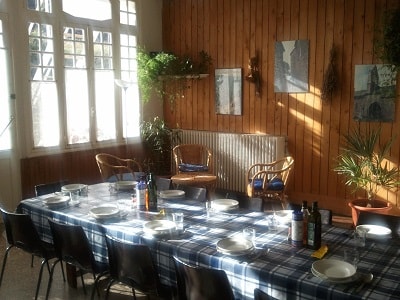 The ghost of Stevenson helped to keep ‘L’Etoile’ shining. Strategically placed on both the
route of the 1878 trek and a north-south railway line, L’Etoile Guest house was quickly found on a web
search for available accommodation. The proprietor had cannily organised useful information
on the walk, so that it would be picked up by keywords such as ‘Stevenson trail
accommodation’ with the search engines. He also had websites in several languages.
The ghost of Stevenson helped to keep ‘L’Etoile’ shining. Strategically placed on both the
route of the 1878 trek and a north-south railway line, L’Etoile Guest house was quickly found on a web
search for available accommodation. The proprietor had cannily organised useful information
on the walk, so that it would be picked up by keywords such as ‘Stevenson trail
accommodation’ with the search engines. He also had websites in several languages.
Why had Stevenson set out this journey? Apart from the search for material for this second
book, the explanations seem to be God and love. Since 1873 Stevenson had been living a
Bohemian existence in and around Paris, where he fell in love with Fanny Osbourne, a
married American woman ten years his senior. She was separated from her husband and
living in France with their two children. In those more God-fearing days when divorce was
difficult, Stevenson’s desires were frustrated by social convention and fear of parental
disapproval. In 1878 Fanny returned to California to try to obtain a divorce, leaving
Stevenson in France. Love-sick and alone, he headed south for his journey.
Why did he choose this route? Actually, it starts in the Velay region and the Cevennes are
not reached until about half way. But the Velay region is less well known, and Travels with a
Donkey in the Velay and the Cevennes is a less economical title. Stevenson travelled to Le
Puy-en-Velay by train. It is an ancient city and one of the four starting points in France for
the pilgrimage route to the shrine of St James in Santiago de Compostela. Within and around
the town are some spectacular volcanic pinnacles or puys, one about 80 metres above street
level. It seems that Stevenson came to the Velay because of its volcanoes. The region around
the city of Le Puy en Velay is peppered with numerous volcanic cones, some active as recently as eight
thousand years ago.
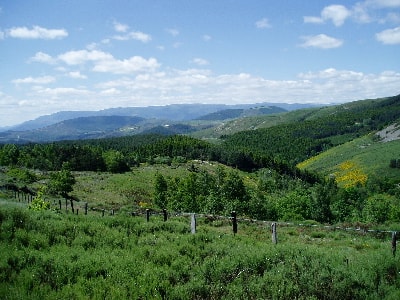 Geology in general and vulcanology in particular were enormously popular in Victorian
times. Charles Darwin and others had challenged the belief in a Divine creation. Fossils and
volcanoes were regarded as evidence of a much greater longevity of the Earth and the species
upon it. Although his father was a strict Protestant, Stevenson regarded himself as an atheist. He came to Velay to witness evidence against the literal and fundamentalist interpretation of
the Bible, according to which the Earth was created around six thousand years ago.
Geology in general and vulcanology in particular were enormously popular in Victorian
times. Charles Darwin and others had challenged the belief in a Divine creation. Fossils and
volcanoes were regarded as evidence of a much greater longevity of the Earth and the species
upon it. Although his father was a strict Protestant, Stevenson regarded himself as an atheist. He came to Velay to witness evidence against the literal and fundamentalist interpretation of
the Bible, according to which the Earth was created around six thousand years ago.
Stevenson was raised by his nanny, Alison Cunningham. She had strong Calvinist views.
Under her strict regime Stevenson was obliged to pray regularly. Although he was very fond
of this woman, he had to get her religious indoctrination out of his system. Religion was also his stimulus for going to the Cevennes. Much of southern France
became Protestant in the sixteenth century, and the whole area became enflamed in the long,
barbarous Wars of Religion. After the revocation of the Edict of Nantes in 1685, Protestants
throughout France were ruthlessly persecuted and forced to worship in secret. Four hundred
thousand left the country and many settled in England. In 1702 a Protestant revolt erupted in
the Cevennes. A guerrilla army kept the authorities in check for more than two years, and
resistance smouldered for long after that. They were called Camisards after the Occitane
word camisa for shirt, which differentiated them from the French royal army in its uniform
and armour.
Why did I set out on this journey? Neither love, nor God. I did miss my wife, but she is
not keen on longer walks and I would not ask that she join me. I wanted to get a bit fitter, lose
a bit of weight and lower my cholesterol count. But all that I could do more effectively by a
few regular hours in the pool of the gym. So what was the main reason? It was not God but
email.
 Email? Let me explain. I travel a great deal. Often a holiday is a few days added to a
lecture trip in some attractive global location. The laptop is with me when I work and make presentations. Like everyone in a similar occupation, I am inundated by emails. Many are
spam and can be deleted immediately. But there is a significant number among the remainder
where the sender expects a response within two or three days. These modern locusts chew
into available hours and require regular disinfection almost every day. The intended line
between work and leisure begins to disappear.
Email? Let me explain. I travel a great deal. Often a holiday is a few days added to a
lecture trip in some attractive global location. The laptop is with me when I work and make presentations. Like everyone in a similar occupation, I am inundated by emails. Many are
spam and can be deleted immediately. But there is a significant number among the remainder
where the sender expects a response within two or three days. These modern locusts chew
into available hours and require regular disinfection almost every day. The intended line
between work and leisure begins to disappear.
It has all happened rather quickly. I remember surviving for a couple of months without
email in 1996 when my email system at work needed fixing. I delighted in this severance, but
I would not dare for it to be repeated today. In 1997 I took my computer with me on a family
holiday when the children still accompanied us, to my wife’s disapproval. Pressure of work
meant that I had to finish something important and behind schedule. By the early years of the
new millennium the desire was for an Internet connection at the holiday hotel, to manage the
flow of emails when away.
Other professionals were obviously in the same position, as within a few years any global
hotel of standing was offering Internet access. At first the prices were exorbitant, but fierce
competition to supply so many customers forced most hotels by 2008 to offer this service for
free. In the Aveyron on the previous two mornings I had joined my brother – an Account
Manager for a large drugs company – while both of us were supposed to be on holiday, to
catch up with our urgent emails. This affliction is not confined to academics.
The only way is to go backpacking for several days. The laptop is too heavy to carry and
must be left behind. The line between work and leisure becomes visible again. But it will not
last for much longer. It is predicted that the ubiquitous hotel-room telly will be soon replaced
by a multiple-purpose unit, linked to the Internet and serving not only as a computer and a
television but also as an entertainment machine. Perhaps via biometric personal
identification, such as the iris or the fingerprint, it will be possible to log on and access
personal data and emails. Bars as well as hotels would provide this service. Perhaps we have
ten years left before the laptop jettisoning manoeuvre is unviable. Even before the ubiquitous
instalment of computer-television hybrids we have already small hand-held devices and
telephones to access the Internet.
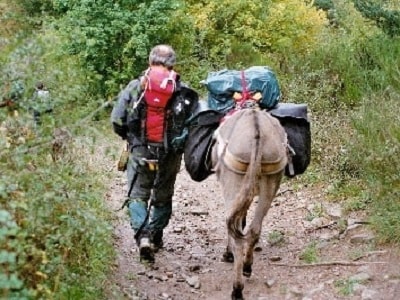 Perhaps ten years is too optimistic. So avoidance of email is the reason. But why did I choose the Stevenson Trail in
particular? I am familiar with his works and I loved Treasure Island and Kidnapped as a
child, but I now hold him in no special affection as a writer. If I had known of a trail
associated with William Shakespeare, John Donne, Thomas Hardy or D. H. Lawrence, then it
would have been further up my list of considerations. Here age has a story to tell. I have done a lot of walking in mountains and I have
especially enjoyed protracted backpacking in uplands alone and with friends. Five of us did a
wonderful seven-day walk in the high Pyrenees in 1995. But as my fitness deteriorated, heavy
backpacking expeditions on mountains in 2001 and 2006 were abandoned. It has become too
much for me to climb for sustained periods with a heavy load including food for several days,
cooking equipment and a tent. I have downgraded to expeditions requiring spare clothes and
few additional items only. Given this, there are several European long distance trails where overnight stops at catered
accommodation are possible. My particular interest in the Stevenson Trail was prompted
when our neighbour at our house in France gave me a French translation of Stevenson’s Cevennes Journal as a present. The trail was not far away from our house in France, and with
relatively few arduous ascents it seemed a good route to try to regain some of my previous
physical fitness.
Perhaps ten years is too optimistic. So avoidance of email is the reason. But why did I choose the Stevenson Trail in
particular? I am familiar with his works and I loved Treasure Island and Kidnapped as a
child, but I now hold him in no special affection as a writer. If I had known of a trail
associated with William Shakespeare, John Donne, Thomas Hardy or D. H. Lawrence, then it
would have been further up my list of considerations. Here age has a story to tell. I have done a lot of walking in mountains and I have
especially enjoyed protracted backpacking in uplands alone and with friends. Five of us did a
wonderful seven-day walk in the high Pyrenees in 1995. But as my fitness deteriorated, heavy
backpacking expeditions on mountains in 2001 and 2006 were abandoned. It has become too
much for me to climb for sustained periods with a heavy load including food for several days,
cooking equipment and a tent. I have downgraded to expeditions requiring spare clothes and
few additional items only. Given this, there are several European long distance trails where overnight stops at catered
accommodation are possible. My particular interest in the Stevenson Trail was prompted
when our neighbour at our house in France gave me a French translation of Stevenson’s Cevennes Journal as a present. The trail was not far away from our house in France, and with
relatively few arduous ascents it seemed a good route to try to regain some of my previous
physical fitness.
Incidentally, the original notebook compiled by Stevenson while on his journey was rediscovered
in the 1970s in Yale University Library in the USA, and then published in English
and in French, to join the many editions of Travels with a Donkey proper. If it were not for Treasure Island and Kidnapped, then few would have taken much notice
and no-one would be walking Stevenson Trail today. Indeed, it was only after two world wars
and the appearance of films and TV serials based in his works that the trail became
established as a popular long-distance hike. An American named Betty Gladstone,
accompanied by her twelve and eighteen year old daughters and a donkey, walked the whole
route from Monastier to St Jean du Gard in May 1963. In 1965 she donated a commemorative
granite plinth that records the start of Stevenson’s journey in Monastier. Two American
women, Carolyn Patterson and Cotton Coulson, a senior editor and a photographer from National Geographic, set out from Monastier on 22 September 1977, exactly ninety-nine
years after Stevenson. They too had a donkey named Modestine. They tried to follow the
Scotsman’s route as closely as possible, but encountered the intrusions of motor traffic on
some of the roads. They stayed the night in the same places as RLS, and slept rough where he
had done so.
 The illustrated story of the Patterson-Coulson journey appeared in the National
Geographic in the following year, ready for the centenary. To mark that occasion, a group of
six writers and journalists set out on the journey after a reception put on by the local
politicians in Monastier. They were greeted en route by groups of locals and tourists. Many others have now followed. The Stevenson Trail thus obtained iconic status less than
thirty years ago. One can only imagine the many unacknowledged walking trails laid down
by budding but unsuccessful writers, who failed to publish their Travels, or who never wrote
a bestseller like Treasure Island, or who never had their works serialised on TV, or whose
gem of a travel journal lies undiscovered in a library vault. (Perhaps Shakespeare kept a journal when he wandered northwards to Scotland in his ‘lost
years’ of 1585-1596, where he was thus inspired to write Macbeth. Such an unlikely
supposition is no more fanciful than the boundless biographical speculations based on the
minimal documented evidence that exists about his life.)
The illustrated story of the Patterson-Coulson journey appeared in the National
Geographic in the following year, ready for the centenary. To mark that occasion, a group of
six writers and journalists set out on the journey after a reception put on by the local
politicians in Monastier. They were greeted en route by groups of locals and tourists. Many others have now followed. The Stevenson Trail thus obtained iconic status less than
thirty years ago. One can only imagine the many unacknowledged walking trails laid down
by budding but unsuccessful writers, who failed to publish their Travels, or who never wrote
a bestseller like Treasure Island, or who never had their works serialised on TV, or whose
gem of a travel journal lies undiscovered in a library vault. (Perhaps Shakespeare kept a journal when he wandered northwards to Scotland in his ‘lost
years’ of 1585-1596, where he was thus inspired to write Macbeth. Such an unlikely
supposition is no more fanciful than the boundless biographical speculations based on the
minimal documented evidence that exists about his life.)
In the 1990s the Stevenson Trail became incorporated in the French system of walking
routes (grandes randonnees) and has been given the number GR®70. Apart from the
annoyances of motor traffic, following exactly in Stevenson’s footsteps is difficult for
additional reasons. In places his precise route is unrecorded and unclear. He sometimes got
lost. He had bad maps and he was not a good map-reader. Often the locals were unhelpful. Finally, the well-signed GR®70 version of the walk has been designed to avoid some metalled
roads where possible, rather than to follow Stevenson exactly. The original Stevenson route has its meandering idiosyncrasies. Within its general drift
from north to south, it lunges first to the west to Le Bouchet St Nicolas, moves south again,
follows a large protrusion to the west through Fouzillac and Le Cheylard-l’Évêque, deviates
eastwards to take in a Trappist Monastery, and takes a long veer westwards to reach Florac,
before turning sharply southeast towards the final destination of St Jean du Gard. Stevenson took twelve days, although he stopped for several half-days to write up his
journal. I had only eight full days and two half days available, and no donkey to carry my
luggage. So I decided to simplify the route a little, and cut a few corners where necessary.
 3 July 2008
3 July 2008
That morning, and without a tinge of remorse, I left my Ford Mondeo-stine in the car park at
the guesthouse L'Etoile. I caught the 9.11 am train from La Bastide-Puylaurent to Langogne, a distance of 20
kilometres. With my carte senior the fare was less than 2 euros. From Langogne I took the
bus to Le Puy-en-Velay at a cost six times more for less than twice the distance. The taxi for
the mere 12 km to Monastier sur Gazeille cost four times as much as the bus fare. I did a quick financial
extrapolation and decided that I would have to start walking.
The bus trip from Langogne to Le Puy en Velay traversed the high Velay plateau on the N88 route
nationale. I had passed this way several times before. Much of the area being over 1000
metres above sea level, it can be cool on an August day. From the car the scenery seems
featureless and unattractive, punctuated by a few dreary villages. But away from the high
road the area is serrated by attractive, steep-sided valleys, best accessed on foot. Also visible
from Monastier and other parts of the Velay, are the many humps of extinct volcanoes. With
more primitive and less rapid modes of conveyance, the area becomes more interesting.
Monastier-sur-Gazeille has little to justify the month that Stevenson spent there in preparation for his
walk. It is a jumble of old buildings with some minimal attempts at restoration. It does
command a good vista of several of the surrounding volcanoes, and he sketched such a view
in his Journal. As if to remind visitors that they had not stepped back into the nineteenth
century, a five-metre banner commemorating the 130th anniversary of Stevenson’s walk was
draped across the street. The same banner with its sponsorship logos from regional
development authorities was found in prominent places in almost every town on the route. In
typical French manner, at some stage the regional political elites had decided to use the RLS
trek as a shameless means of promoting their area. Presumably they had marked the 120th and
the 125th anniversaries, and they will go for the one in 2018 as well. 2028 will be a Jamboree. It was just after midday and it had started to rain. I decided to stop at a local bar for a cup
of tea. There were four locals at the bar and a middle-aged lady behind, who gave me a blank
stare. One local slurred his speech and another seemed like a Gallic version of John Mills
‘Michael’ in the movie Ryan’s Daughter. One of the more sober locals kindly repeated my
request for ‘un the aux citron’ and the lady looked at me as if I was asking for an exotic
drink. I had a coffee instead. The local politicians have more work to do, if promoting their
region means making it accommodating for tourists. I passed Mrs Gladstone’s granite plinth and headed towards the volcanic pimples. I could
see several of them ahead through the drizzle, each reaching a height of about 1100 metres
above the 1000 metre plateau. Once this district was a boiling cauldron of lava. I saw
volcanic scree on the hillside and the path was covered with granite pebbles and rocks.
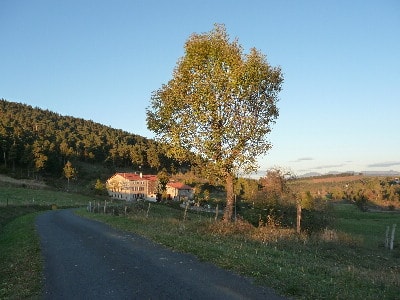 Given my afternoon start, my plan was to make the 13 kilometres to Goudet, where there
is a gîte d’etape. Although the going was not flat I made good time. At 3pm I was at St
Martin de Fugeres, where I took a beer at a bar. I had two guidebooks with me, one in
English and the other in French. The English guide noted that there was plenty of
accommodation in Costaros, which was off the official GR®70 route but a place through which
Stevenson had passed. Temporarily more devoted to Stevenson’s actual route, I calculated I
could make it to Costaros and find accommodation there. This would mean completing an
overall distance of just over 23 kilometres in the day.
Given my afternoon start, my plan was to make the 13 kilometres to Goudet, where there
is a gîte d’etape. Although the going was not flat I made good time. At 3pm I was at St
Martin de Fugeres, where I took a beer at a bar. I had two guidebooks with me, one in
English and the other in French. The English guide noted that there was plenty of
accommodation in Costaros, which was off the official GR®70 route but a place through which
Stevenson had passed. Temporarily more devoted to Stevenson’s actual route, I calculated I
could make it to Costaros and find accommodation there. This would mean completing an
overall distance of just over 23 kilometres in the day.
When I emerged from the bar the rain had stopped. I descended into the hamlet of Goudet,
nestling in the infant valley of the Loire. Crossing the bridge, I had a good view of the
Château Beaufort above the river. After taking a photograph I flicked through one of the
guidebooks and discovered that Stevenson had sketched the same view in his Journal.
I made the same long ascent up the road from Goudet to Ussel, where RLS had had such
difficulty encouraging Modestine. At the hamlet of Ussel the pack had fallen off her back,
and Stevenson was obliged for a while to carry it himself, much to the laughter of the locals.
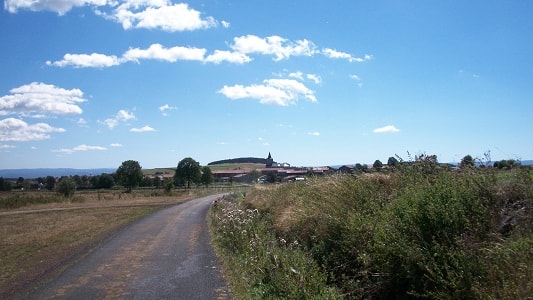 I pushed on and reached Costaros at about 6.30 pm. Stevenson described it as ‘an ugly
village on the high road’. It has not changed, except that the high road is now the N88 and the
town is made even more unpleasant by the noise of heavy lorries. I saw the sign of a hotel
ahead but to my dismay I found it had closed down. I went into a bar for another beer and to
enquire about accommodation. ‘Rien’ was the reply. The English guidebook, published in
1992, was hopelessly out of date. The locals had missed a trick and had not put a Stevenson
banner across the street.
I pushed on and reached Costaros at about 6.30 pm. Stevenson described it as ‘an ugly
village on the high road’. It has not changed, except that the high road is now the N88 and the
town is made even more unpleasant by the noise of heavy lorries. I saw the sign of a hotel
ahead but to my dismay I found it had closed down. I went into a bar for another beer and to
enquire about accommodation. ‘Rien’ was the reply. The English guidebook, published in
1992, was hopelessly out of date. The locals had missed a trick and had not put a Stevenson
banner across the street.
I had the two options of either Le Bouchet St Nicolas five kilometres ahead or Goudet ten kilometres
behind. I asked if I could use the bar phone, which turned out to be the proprietor’s mobile. Grudgingly he passed it to me and I booked a bed in the gîte (Guest-house) in Le Bouchet. I said I would be
there before 8 pm.
A minute later the proprietor received a return call on the same phone, informing him that
my communicant at Le Bouchet Saint Nicolas would come to collect me by car. How could I refuse this
generosity, particularly when contrasted with the mean proprietor who charged me fifty cents
for the phone call? I rationalised my contravention of the rule that I would travel on foot by
noting that it was only five kilometres, and Le Bouchet was slightly further from tomorrow’s
destination than Costaros. My kind host arrived and took me to Le Bouchet and his gîte
communal, which means sleeping in a dormitory with others. I took one of the two spare beds
available and dashed for the shower while it was free. My host and his wife also ran the local
auberge, where I had a good meal with a notably excellent course of Puy en Velay lentils with cream. I was asleep by 10 pm, before my companions had come to the room. In the early hours I
was awakened by what sounded like a generator outside. After a while I realised that it was
the noise of a roommate’s groaning CPAP (continuous positive airway pressure) machine,
designed to alleviate sleep apnoea by pumping air down the throat via a mask. I might have
slept better with the sound of his snoring.
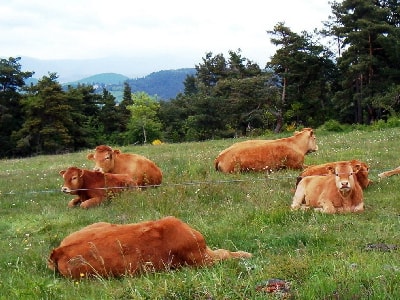 4 July 2008
4 July 2008
I arose early to a grey, cold morning. Le Bouchet St Nicolas is yet another dismal village on the high
plateau, with four months of winter and two of summer. Its cluster of dilapidated farms smelt
of silage and cow shit. Yet its 130th anniversary banner was proudly displayed across the
street. Why had Stevenson come to this dreary place, after a long trek westwards, taking him
no further towards his final destination in the south? He was trying to find Lac du Bouchet,
two kilometres to the north, which has a diameter of 800 metres and occupies a volcanic
crater. Partly because of the unhelpful locals, he failed to find this feature. It was one of
several of his worthless detours, yet it survives on the route at least because it is one of the
few places in this district with accommodation.
I was early for the appointed hour of my breakfast. My baguette was delivered by van at
8 am. It was not fresh and I guessed that it had been baked the preceding day. I sat down at a
table in the bar with the accompanying coffee. Why do many French establishments still
believe that it is sufficiently elegant to eat bread without a plate? A few minutes later two
more Gallic Michaels tottered into the bar and ordered their alcoholic shots. Sure enough, if I
lived in this place I would be driven to drinking at such an hour. For his final act of kindness to myself, my host gave unprompted directions to the
continuation of the Chemin de Stevenson from the village. It was a straight, solitary track
across the meadows. There were many wild flowers and trees of scented elderflower. On the
left there were several volcanic pimples, mostly about 1200 metres above sea level but no
more than 100 metres above the plateau. Denuded monuments of earthly and ungodly
powers.
In Britain a Munro is classified as a mountain of over 913 metres (3000 feet) above sea
level. As a lapsed Munro-bagger it occurred to me that I could climb dozen of these pimples
in a couple of days, thus bagging a good number of Gallic Munros. Then I remembered that
to qualify a Munro has to be separated from other features by a drop of over 500 feet on
every side. Despite each being almost as high as Ben Nevis, one at most of these volcanic
pimples would qualify.
 As I walked on the weather improved. After the village of Landos, the sun broke through
the clouds and the air became pleasantly warm. I heard a fox cry out from a small wood upon
one of the volcanic tops.
My English guidebook recommended the attractive and historic town of Pradelles as the
destination for the day. The French guidebook, published in 2007, also claimed that there was
accommodation there. It would have meant a day’s walk of 24 kilometres. But I kept open the
option of pressing on another five kilometres to Langogne, where I had noticed several hotels
on the preceding day.
As I walked on the weather improved. After the village of Landos, the sun broke through
the clouds and the air became pleasantly warm. I heard a fox cry out from a small wood upon
one of the volcanic tops.
My English guidebook recommended the attractive and historic town of Pradelles as the
destination for the day. The French guidebook, published in 2007, also claimed that there was
accommodation there. It would have meant a day’s walk of 24 kilometres. But I kept open the
option of pressing on another five kilometres to Langogne, where I had noticed several hotels
on the preceding day.
The route began to descend slowly, with views westwards across the wide valley of the
Allier. I passed through a pine forest and entered the town of Pradelles. Although also
situated aside the dreaded N88, its interesting parts are sufficiently away from the traffic
noise. I noted the remains of its town ramparts and gates, but like Stevenson I avoided the
famous wooden Virgin of Pradelles in the Church of Notre Dame, brought back by a crusader
and said to be responsible for a number of miracles.
The countryside changed as I left Volcanoland behind. Ahead was a rolling and much
wooded landscape, reminiscent of parts of Northumberland. I pressed on to Langogne over
open fields with a view of the large Reservoir de Naussac in the distance. I found a hotel in
good time for a shower before dinner. Like me, Stevenson had made it to Langogne on the
second day of his walk. His much earlier start from Monastier sur Gazeille was compensated by my fivekilometre
lift in a car. I was over a day ahead of my own schedule.
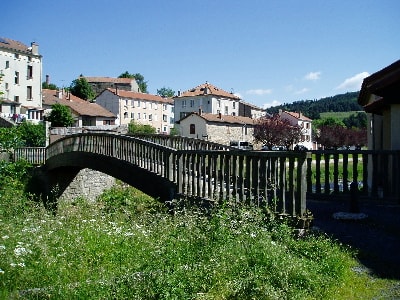 5 July 2008
5 July 2008
For some obscure reason, Stevenson had headed southwest from Langogne towards the
village of Cheylard l’Eveque. He planned to then go on to the village of Luc the next day.
Why didn’t he take the direct southerly route to Luc through the attractive Allier valley,
which would have meant one day’s travel rather than two? In fact he got lost before he
reached Cheylard, and was obliged to sleep rough in a storm. Cheylard has no special point of
interest, so why did he go there? Was it simply the name – meaning Cheylard-the-Bishop –
and his enduring atheistical fascination with religion?
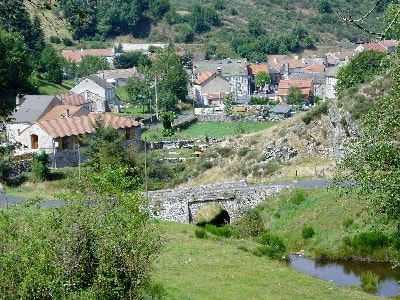 After the event he may have regretted this uncomfortable and seemingly worthless detour. Yet it prompted one of the most famous passages in his Travels in the Cevennes: Why anyone should desire to visit either Luc or Cheylard l'Evêque is more than my much-inventing
spirit can suppose. For my part, I travel not to go anywhere, but to go. I travel for travel’s
sake. The great affair is to move; to feed the needs and hitches of our life more nearly; to
come down off the feather-bed of civilisation, and find the globe granite underfoot and
strewn with cutting flints. Alas, as we get up in life, and are more preoccupied with our
affairs, even a holiday is a thing that must be worked for. To hold a pack upon a packsaddle
against a gale out of the freezing north is no high industry, but it is one that serves to
occupy and compose the mind. And when the present is so exacting, who can annoy
himself about the future?
After the event he may have regretted this uncomfortable and seemingly worthless detour. Yet it prompted one of the most famous passages in his Travels in the Cevennes: Why anyone should desire to visit either Luc or Cheylard l'Evêque is more than my much-inventing
spirit can suppose. For my part, I travel not to go anywhere, but to go. I travel for travel’s
sake. The great affair is to move; to feed the needs and hitches of our life more nearly; to
come down off the feather-bed of civilisation, and find the globe granite underfoot and
strewn with cutting flints. Alas, as we get up in life, and are more preoccupied with our
affairs, even a holiday is a thing that must be worked for. To hold a pack upon a packsaddle
against a gale out of the freezing north is no high industry, but it is one that serves to
occupy and compose the mind. And when the present is so exacting, who can annoy
himself about the future?
Clearly there is no special reason to take the detour to Cheylard l’Évêque. Today it is not
even possible for anyone to claim to be following faithfully in Stevenson’s footsteps, for RLS himself became lost. I decided that I would take the direct route to Luc and on to La Bastide-Puylaurent,
where I had parked my car. I would follow the attractive route by ascending the narrowing
Allier valley, cut through by the railway upon which I had travelled two days before. If the
great affair is to move, I could thus take the route I wished, and Stevenson’s ghost would not
be offended. The alternative route via Cheylard l'Evêque seemed mere pedantry. There is something too be said for feeling more nearly ‘the needs and hitches of our life’.
On my travels I have often come down off the feather-bed of civilisation. But being well over
twice Stevenson’s age in 1878, descent onto the turf is more difficult, and I cherish a softened
bed all the more. So I started out on the 20 kilometres towards La Bastide-Puylaurent. The picturesque upper valley of
the Allier reminded me of the Tyne Valley above Hexham in Northumberland, which also
carries a working railway. But I soon found a good reason to take the detour to Cheylard
l’Évêque. There is no footpath along the valley and for most of the way I was obliged to
trudge along the D906 road. The holiday traffic greatly detracted from the beauty of the
place.
 This area is known as Gevaudan. In 1764 a huge wolf was reported in the area. For three
years the Beast of Gevaudan ravaged the land, reportedly killed over a hundred women and
children. A wolf was found and killed, but the attacks continued. The King of France was so
alarmed that he sent an expert hunter, who tracked down and shot a second beast. The attacks
ceased. Now the Beasts of Gevaudan have four wheels. The legend of the Beast of Gevaudan was an inspiration for a successful 2001 French film
by Samuel Le Bihan entitled Brotherhood of the Wolf.
This area is known as Gevaudan. In 1764 a huge wolf was reported in the area. For three
years the Beast of Gevaudan ravaged the land, reportedly killed over a hundred women and
children. A wolf was found and killed, but the attacks continued. The King of France was so
alarmed that he sent an expert hunter, who tracked down and shot a second beast. The attacks
ceased. Now the Beasts of Gevaudan have four wheels. The legend of the Beast of Gevaudan was an inspiration for a successful 2001 French film
by Samuel Le Bihan entitled Brotherhood of the Wolf.
At one great bend in the river, followed dutifully by the main road and the railway, I took
one short cut along a private road through a wood. Near a farm off the road at La Maguelone, I saw an ancient wayside cross girded by flowers. By midday I was at Luc, which Stevenson
had taken two days to reach from Langogne. I chatted with the locals and one showed me a
fine basket of mushrooms he had gathered in the fields. I rejoined the Stevenson trail and for
some way it departed from the noisy D906. I got to La Bastide-Puylaurent in the mid-afternoon. The temperature was displayed in the village as 30 degrees.
 Obeying Roman Army rules, three days hard marching would be rewarded by a day’s rest
and recuperation. I had booked in for two nights at the Guest-house ‘L’Etoile’. I had walked
63 kilometres in two-and-a-half days. I was well ahead of Stevenson and my own schedule. I
opened up my car, took out my laptop, and began writing my notes of the journey. I managed
to avoid my emails until the next day.
Obeying Roman Army rules, three days hard marching would be rewarded by a day’s rest
and recuperation. I had booked in for two nights at the Guest-house ‘L’Etoile’. I had walked
63 kilometres in two-and-a-half days. I was well ahead of Stevenson and my own schedule. I
opened up my car, took out my laptop, and began writing my notes of the journey. I managed
to avoid my emails until the next day.
As I noted before, Stevenson had passed through La Bastide-Puylaurent on his way from Luc. His
immediate destination was the Trappist monastery at Notre-Dame-des-Neiges, requiring a
detour three kilometres to the east. It was not simply to get a bed for the night. His
preoccupation with godly matters remained. As he wrote in his Travels with a Donkey: I had rarely approached anything with more unaffected terror than the monastery of our
Lady of the Snows – fear took hold of me from head to foot. Clearly, religion in general – and fear of Catholicism in particular – was something he had to
exorcise. Today the monks are no longer bound by strict vows of silence and they tempt
tourists with sales of their home-made honey and table wine. I had no inclination to visit this
Trappist tourist trap.
6 July 2008
Emulating Stevenson, I spent much of the day writing up my journal. I caught up with the
global news. There were only two hundred emails to be processed. I had been let off lightly. It was a dull and cool day – more suited for rest than exploration.
 7 July 2008
7 July 2008
Apart from at the evening at the end, Abigail was the only Brit I talked to on my seven-day
adventure. She was originally from South Wales but had been living and working in Dublin
for several years. At breakfast that morning she said that she planned to get as far as the
village of Le Bleymard. As this was my objective too, we agreed to walk together. As I paid
the bill, Monsieur Philippe joked that we could cut our journey short by getting the morning
train to Chasserades, and said: ‘I shall not tell anybody’.
From La Bastide-Puylaurent the GR®70 makes yet another deviation from Stevenson’s historic route by
climbing and skirting the hills to the right of the valley floor for six kilometres. There was not
much traffic and we decided to stick to the road instead. We would save up to an hour on a long day’s walk. Sure enough, we quickly
regained the GR®70 and were at Chasserades in a couple of hours. It is a pretty village with a
lovely twelfth-century Romanesque church, built on an outcrop of rock.
Although only about 1.5 metres tall, Abigail is a strong walker. Bits of conversation
during the day led me to guess that she was a Roman Catholic. She told me that she had once
walked the last hundred kilometres of the pilgrim’s route to Santiago de Compostela to obtain
an indulgence to give to her brother for a wedding present.
The roadways of France have plentiful wayside crosses. I noticed that simpler crosses of
plain iron were becoming more common than the RC-favoured ornament of the tortured
Jesus. In this district there were no indulgences to be purchased for our pains.
The first ten kilometres of our walk were close to the railway from La Bastide-Puylaurent to Mende.
A single-line track being surveyed during Stevenson’s visit, it had suffered no Beeching and
it was still running trains across the high terrain. From Chasserades the path goes through the
small villages of Mirandol and L’Estampe. Stevenson had noted that the ‘narrow street of
Estampe was full of sheep, black and white all bleating and tinkling with bells around their
necks.’ It was much quieter today.
The weather was cool but the cloud cover was diminishing. Our route turned south up into
the hills and through forests of beech and pine. At the top of the ridge the rolling Cevennes came into view. The official GR®70 takes a winding detour past the source of the River Lot.
Imagining a place of little more interest than a gurgling ditch, we took a more direct route
down a forest track through the hamlet of Les Alpiers to our destination in Le Bleymard. I
saw an eagle rise far ahead, alarmed by our approach.
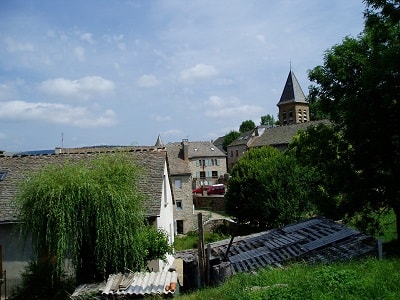 On the edge of the Cevennes National Park, the village of Le Bleymard bustled with just a
little tourism. A coach party of Cambridgeshire sixth-formers were visiting the small
supermarket. A gaggle of French cyclists in bright clothes paused beside the road. Like a
flock of geese, they moved and swayed on their machines. After a while they suddenly glided
off, to follow their tacit leader up the road. It was here in Le Bleymard that I witnessed the dawn of Das Stevensonkitsch. Keyrings
with stuffed, grey Modestines; t-shirts with a Stevenson-Modestine logo; posed postcard
photos of men leading donkeys; and a comic book in French relating Stevenson’s Travels
with a Donkey. A small start; a lot of potential for the future. How about pottery figures of
Stevenson and Modestine for the mantelpiece? Or cuddlier Modestines to take to bed? Or
plastic inflatable donkeys to ride in the swimming pool?
On the edge of the Cevennes National Park, the village of Le Bleymard bustled with just a
little tourism. A coach party of Cambridgeshire sixth-formers were visiting the small
supermarket. A gaggle of French cyclists in bright clothes paused beside the road. Like a
flock of geese, they moved and swayed on their machines. After a while they suddenly glided
off, to follow their tacit leader up the road. It was here in Le Bleymard that I witnessed the dawn of Das Stevensonkitsch. Keyrings
with stuffed, grey Modestines; t-shirts with a Stevenson-Modestine logo; posed postcard
photos of men leading donkeys; and a comic book in French relating Stevenson’s Travels
with a Donkey. A small start; a lot of potential for the future. How about pottery figures of
Stevenson and Modestine for the mantelpiece? Or cuddlier Modestines to take to bed? Or
plastic inflatable donkeys to ride in the swimming pool?
The Hotel le Remise at Le Bleymard offers half-board at excellent value. One of the
waitresses at dinner was especially pretty, although she seemed new to the job and did not
know the names of the cheeses on offer. Stevenson had noted the beauty of a waitress and
chatted to her at Le Pont-de-Montvert, which was to be our destination the next day. Here
was another entrepreneurial opportunity for the Tourist Board – ensure that every lodging in
Le Bleymard, and especially in Le Pont-de-Montvert, has a pretty waitress, to ensure that
every authentic traveller in Stevenson’s footsteps can replicate the historic flirtation.
 8 July 2008
8 July 2008
Le Pont-de-Montvert was to be reached over Mont Lozere. Thirty kilometres from east to
west, Nicholas Crane compared this mountain to a baguette. We were to cross from north to
south. The first three kilometres were largely through forest, up to the ski station at 1421
metres above sea level. At a greater height than Ben Nevis, the resort was struggling in the
age of cheap travel and global warming. The summit was just two kilometres ahead, the route
across the moor being marked by ancient standing stones called montjoies.
It was a bright, clear, sunny day and the view from the top was magnificent. To the west
was the Ardeche plateau, with Mont Mezenc and Gerbier de Jonc. Beyond were the traces of
the Rhône valley, leading south to the Camargue and the Mediterranean. Directly to our south
were the rolling blue-green waves of the Cevennes. At 1699 metres this was the highest point
of the whole journey, and exceeded in the whole of the Massif Central by Mont Mezenc and
the volcanic puys of Mont Dore and Cantal. Coming off the summit we made our way through a huge flock of sheep, moving unguided
as a herd. We descended through the pines, near where Stevenson had camped the night
under the stars. Emerging from the forest, I missed the turn to Finiels. Instead we were
marching south along a ridge towards a large rock formation. But the path petered out to
nothing, so I suggested a short descent off the ridge to regain the path. This proved trickier
than it seemed at first sight, because the rough, boulder-strewn hillside was boggy in parts
with frequent brambles and nettles.
 The GR®70 path regained, we strolled into the pretty village of Le Pont-de-Montvert, built at
the confluence of the Tarn, Rieumalet and Martinet rivers. It was here that the War of the Camisards had started.
The GR®70 path regained, we strolled into the pretty village of Le Pont-de-Montvert, built at
the confluence of the Tarn, Rieumalet and Martinet rivers. It was here that the War of the Camisards had started.
François Langlade, the Abbe du Chayla, was the brutal Catholic governor of the district.
He delighted in the torture of Protestant prisoners in the cellar of his house. In 1702 a gang of
about fifty locals set out to free these captives and murdered the Abbe at Le Pont-de-Montvert, thus triggering the uprising of the Camisards. Esprit Seguier, the leader of the
killing, was caught within a few days. His right hand was severed before he was burnt alive. Les autres, duly encouraged, burned Catholic churches and murdered the priests. The
Protestants organised themselves into a guerrilla army, under the leadership of Jean and
Roland Cavalier. The guerrillas took advantage of the remote mountain topography. The
royal army burned hundreds of local villages and massacred their inhabitants. The Camisards
suffered a major defeat in 1704 and their leaders were betrayed, but scattered fighting went
on until 1710. A small Protestant community survived and was largely left in peace,
especially after the death of Louis XIV in 1715. Revolt and resentment came finally to an end
only when the revolutionary government of 1789 granted religious freedom to the
Protestants.
When Stevenson arrived in 1878 he delighted that the majority in the locality remained
Protestant. His intellectual and emotional entanglement with religion survived his atheism. He described the War of the Camisards as ‘a romantic chapter’ in ‘the history of the world.’ It
is a shame that he did not dramatise these historic events in a full-scale novel. On the other
hand, if he had, the area would have long overwhelmed and spoiled by tourists. Stevenson
saved the splendid isolation of the Cevennes. We were drinking our cool beers in a bar only twenty metres from the spot in front of the
clock tower where Esprit Seguier was burnt alive. Like me, Abigail did not have enough
available time to complete the whole route, but in true pilgrimage fashion she wanted to reach
the end of Stevenson’s walk at St Jean du Gard. She would get a taxi that evening to Florac
and move on from there the next day. Perhaps she sensed my preference for being alone, or
had had enough of my navigational errors. I booked in to an indifferent and over-priced small hotel in the village. Yet there I had my
best sleep for weeks.
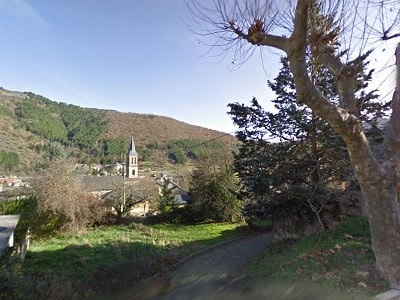 9 July 2008
9 July 2008
After flirting with the waitress at Le-Pont-de-Montvert, Stevenson had taken the road down
the Tarn valley westwards towards Florac, sleeping out on the way. This route is now the
busy D998. ‘For technical reasons’ (it was described in bureaucratic French somewhere), the GR®70 ascends south onto the high ridge, turns west over the Signal de Bouges (1421m),
follows the ridge for much of its extent and reaches Florac in an overall trek of 28 kilometres.
It was a crystal blue day, and the GR®70 clearly took precedence over any fidelity to Stevenson. In my ascent from the village I met a friendly donkey, as if to remind me of Modestine. The cool shade of the pines was welcome as the sun became fiercer. These were the woods from which the Camisard army had launched its operations. With my fatigued pace I made my way into Florac and booked into a hotel. The next day on the official route seemed less attractive, and I decided to end it there. I had walked 141 kilometres in six days. Stevenson had taken nine to reach Florac, although he had taken several half-day breaks to write up his journal. My GPS reported just over 30 hours overall of walking time and 17 hours of stops. My total ascent had been 2328 metres. Near the top of the ridge the GR®70 emerges into open country and the summit of the Signal du Bouges is reached at 1421 metres. At times the views were magnificent. Added to this were carpets of flowering heather capping much of the ridge. I overtook two French couples taking the same route and met a very short man with a dog coming the other way. It was the hottest day I had experienced on my whole journey, and before the end I ran out of water. It was a long and tiring stretch, but the most spectacular of my whole journey. Abigail had missed this treat.
 In the hotel grounds, someone with a clipped accent asked in English whether I was on the
Stevenson Trail. I responded that I was, and he then asked me to join himself and his wife at
the same table for dinner. R was a retired merchant banker with a public school education and
his wife M was French. He was about my age and she was probably about twenty years his
junior. At dinner we made our orders for food. R took hold of the wine list and ordered a
bottle of Gigondas. He insisted in speaking in English to the waiters and said later during our
dinner that it was ‘arrogance’ for the English to do otherwise: ‘They understand perfectly
well.’ When the wine arrived he grabbed it from the waiter and insisted on pouring it himself.
The reason was soon apparent: I was not to be offered any. His wife drank one glass and he
ended up drinking the rest of the bottle. And he had already had a pastis before dinner. Some
kind of excuse was hinted at, with a remark about having to ‘make do’ on their European trip
of 96 days. I discretely ordered two additional glasses of wine for myself. At points during
the dinner conversation both R and M spoke simultaneously, and I had the difficulty of
deciding which line of conversation to follow. This was my re-entry into civilisation.
In the hotel grounds, someone with a clipped accent asked in English whether I was on the
Stevenson Trail. I responded that I was, and he then asked me to join himself and his wife at
the same table for dinner. R was a retired merchant banker with a public school education and
his wife M was French. He was about my age and she was probably about twenty years his
junior. At dinner we made our orders for food. R took hold of the wine list and ordered a
bottle of Gigondas. He insisted in speaking in English to the waiters and said later during our
dinner that it was ‘arrogance’ for the English to do otherwise: ‘They understand perfectly
well.’ When the wine arrived he grabbed it from the waiter and insisted on pouring it himself.
The reason was soon apparent: I was not to be offered any. His wife drank one glass and he
ended up drinking the rest of the bottle. And he had already had a pastis before dinner. Some
kind of excuse was hinted at, with a remark about having to ‘make do’ on their European trip
of 96 days. I discretely ordered two additional glasses of wine for myself. At points during
the dinner conversation both R and M spoke simultaneously, and I had the difficulty of
deciding which line of conversation to follow. This was my re-entry into civilisation.
10 July 2008
I got the bus to Ales and from there returned by train to La Bastide-Puylaurent, where email contact was
again possible. It was another hot day and the train journey was spectacular. Even Stevenson had cut short his walk by a day. Instead of walking all the way to Ales, he
took a carriage there from St Jean du Gard. He missed Fanny Osbourne, and at Ales he was expecting some awaiting mail.
 He married Fanny in 1880. In the same year he was diagnosed as suffering from
tuberculosis. The sunshine and dry air of California were beneficial to his health and it was
there that he wrote Treasure Island (1883), Dr Jekyll and Mr Hyde (1886) and Kidnapped (1886). Then famous, and in receipt of a large advance from a publisher, RLS and Fanny
chartered a yacht in the Pacific, where they visited Tahiti, Hawaii, Micronesia and Australia.
In 1890 he purchased a large tropical estate on the island of Upolu in Samoa where he built a
large house and entertained visiting westerners. He died suddenly and unexpectedly of a
massive cerebral haemorrhage in December 1894. The natives buried him in Samoa on the
summit of Mount Pala.
He married Fanny in 1880. In the same year he was diagnosed as suffering from
tuberculosis. The sunshine and dry air of California were beneficial to his health and it was
there that he wrote Treasure Island (1883), Dr Jekyll and Mr Hyde (1886) and Kidnapped (1886). Then famous, and in receipt of a large advance from a publisher, RLS and Fanny
chartered a yacht in the Pacific, where they visited Tahiti, Hawaii, Micronesia and Australia.
In 1890 he purchased a large tropical estate on the island of Upolu in Samoa where he built a
large house and entertained visiting westerners. He died suddenly and unexpectedly of a
massive cerebral haemorrhage in December 1894. The natives buried him in Samoa on the
summit of Mount Pala.
Stevenson lived at the beginning of that brief 140 year interval between the Long Epoch of
Religion and the New Era of the Internet, bounded by Charles Darwin at one end and Bill
Gates at the other, and bookended by Travels with a Donkey and Crane’s Clear Waters
Rising, when we falsely imagined we could be completely isolated and unto ourselves.
One cannot follow Stevenson’s exact route. You cannot ‘do’ Stevenson’s actual trail.
Forget that objective. It is not a pilgrimage. The point of it all is to see that field of flowers
and to hear the whisper of the wind among the pines. Thus the point of travel is to know. The
point of travel is to grow. The great affair is to be moved; to come down off the car-seat of
civilisation and to enjoy nature more nearly. The GR®70 is neither an escape into the hills nor an historical devotion, but an enjoyable
adventure gently managed by quasi-state functionaries. Be adventurous. Be inventive. Find a
new route into the wild.
And for those of you with little more than three days to spare, take the train to La Bastide-Puylaurent,
or park your car there at ‘L’Etoile’. Enjoy Monsieur Philippe’s excellent company and food.
Walk to Le Bleymard and book into the welcoming and comfortable Hotel La Remise. Take
the GR®70 across Mont Lozere, enjoy the views and descend into historic Le-Pont-de-
Montvert. From there on the next day you can stride the spectacular ridge walk along the GR®70 to Florac. You will have done the best of this trail, and perhaps sensed Stevenson’s
ghost for a while. by Geoffrey M. Hodgson
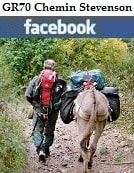 |
Old romantic Hotel, L'Etoile Guest-House is a mountain retreat in the South of France. With a beautiful park along the Allier River, L'Etoile Guesthouse is located in La Bastide-Puylaurent between Lozere, Ardeche and Cevennes. Many hiking trails like GR®7, GR®70 Stevenson trail, GR®72, GR®700 Regordane way, Cevenol, GR®470 Allier River Springs and Gorges, Margeride, Ardechoise. Many hiking loops. The right place to relax.
Copyright © GR®70-stevenson.com